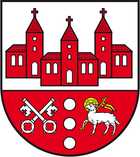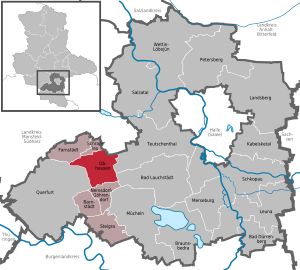Obhausen
| coat of arms | Germany map | |
|---|---|---|

|
Coordinates: 51 ° 24 ' N , 11 ° 40' E |
|
| Basic data | ||
| State : | Saxony-Anhalt | |
| County : | Saalekreis | |
| Association municipality : | Weida land | |
| Height : | 176 m above sea level NHN | |
| Area : | 37.33 km 2 | |
| Residents: | 2249 (Dec. 31, 2019) | |
| Population density : | 60 inhabitants per km 2 | |
| Postcodes : | 06268, 06279 | |
| Primaries : | 034771, 034774 | |
| License plate : | SK, MER, MQ, QFT | |
| Community key : | 15 0 88 265 | |
| LOCODE : | DE OHU | |
| Community structure: | 5 districts | |
| Association administration address: | Hauptstrasse 43 06268 Nemsdorf-Göhrendorf |
|
| Website : | ||
| Mayoress : | Dagmar Nicodemus | |
| Location of the community Obhausen in the Saalekreis | ||
Obhausen is a municipality in the Saalekreis in Saxony-Anhalt . It belongs to the community of Weida-Land , which has its administrative headquarters in the community of Nemsdorf-Göhrendorf .
geography
Obhausen lies between Halle (Saale) and Querfurt on the Weida stream .
Community structure
The following districts are identified:
- Altweidenbach
- Esperstedt
- Doecklitz
- Kuckenburg
- Neuweidenbach
history
In a register of the tithe of the Hersfeld monastery , which was created between 881 and 899, Obhausen is mentioned for the first time in a document as the place of Hubhusa im Friesenfeld, which is subject to a tithing obligation .
In 999 the community was mentioned in a document as Upphusun morcha .
Consists of the parish St. Petri with its branches St. Johannis and St. Nicolai , which belonged to the Merseburg chapter . Four manors belonged to the place (one in St. Petri, the Schieferhof at St. Nicolai, the Hayn'schen and Wagnerische in St. Joh.). Feudal lords were the nobles of Querfurt , the counts of Mansfeld (from the house of the nobles of Querfurt), and the diocese of Magdeburg (the nobles of Querfurt were burgraves of Magdeburg). These enfeoffed the places and the goods in them to the v. Braschwitz (14th – 17th centuries), v. Rolitz, v. Gleina (15th century), v. Osterhausen , v. Kötzschen (17th century), v. Milkau (16th century), v. Rockhausen (1683–1753 St. Joh.), V. Nostitz (1753–1788 St. Joh.), Knuth (Kunth 18th century), v. Krafft (Kraft, 16th - 17th century), v. Trotha (19th – 20th century St. Petri), v. Hayn (18th century), v. Streitwitz (17th century), von der Streithorst (18th century), v. Danckelmann (17th – 18th century St. Joh.), V. Gehofen, v. Naso and those from the corner continue.
The family of Rockenhausen on Kirchscheidungen belonged since 1683 in Obhausen inheritance and free- Allodial - Manor St. John's. The last owners were the district commissioner of the Thuringian district George Friedrich von Rockhausen , Herr auf Obhausen and Albersroda and his only son Friedrich August von Rockhausen.
The Erfurt writer Sidonia Hedwig Zigarunemann wrote the wedding poems on the occasion of the wedding on October 8, 1736 in Obhausen Castle: "Since now the Reichsfreyherr Stettner von Grabenhoff, with his bride the beautiful Fraulein von Rockhausen is married with a lot of pleasure." And "Auf just this marriage ” .
After almost all court and farm buildings in Obhausen were destroyed by fire in November 1750, the von Rockhausen family sold their property to the von Nostitz family in Obhausen in 1752 .
Until 1815 the place was in the Saxon office of Querfurt .
On April 1, 1937, the three communities Obhausen Johannis , Obhausen Nikolai and Obhausen Petri were merged to form the community Obhausen.
On January 1, 2010 Esperstedt was incorporated into Obhausen with Kuckenburg .
Excavations
Archaeologists from the Friedrich Schiller University in Jena have discovered the remains of a church with a choir and apse near Obhausen. It is dated around the year 1000. As early as the beginning of the 20th century, a 3000 year old hoard with jewelry and utensils, including three neck rings of different sizes, was recovered on the mountain spur of the Kranzberg.
In the course of the research project "The hill settlements of the micro and macro region - economic, political-social, administrative and cultic central locations", which concentrates on places within a 40-kilometer radius of Nebra , the legacies have since been used by researchers and students in the Ur - and the early history of the University of Jena.
An early medieval castle (9th century), consisting of a main and outer bailey, was found on the Kranzberg. It now became apparent that a stone building was the foundation of an early church. A hall 20 meters long and 10 meters wide, a rectangular choir seven by seven meters and an apse about three meters in diameter were located. Based on the recovered material, the construction of the church around the year 1000 can be assumed. This means that this building dates roughly at the same time as the church at Querfurt Castle .
politics
Local elections
The local election on September 22, 2013, with a turnout of 39.7%, led to the following result:
| Party / list | Share of votes | Seats |
|---|---|---|
| CDU | 52.2% | 6th |
| left | 23.3% | 2 |
| FDP | 8.7% | 1 |
| Groups of voters | 15.8% | 2 |
mayor
The honorary mayor Kay-Uwe Böttcher was first elected on June 12, 1994.
coat of arms
The coat of arms was approved by the district on April 19, 2013.
Blazon : "In silver over a raised red shield base, three red churches each with a pointed tower with a tower cross, the two outer churches with their towers turned towards the lower central one and slightly covered by the nave on both sides of their tower, the shield base covered with three silver stakes Balls between two diagonally crossed silver keys in front and a gold nimbed silver lamb with gold-red victory flag in the back. "
The colors of the community are: red and white.
Although Obhausen was a small community in the Middle Ages, it had three churches, after which the local areas were named. The patron saints of the churches were St. Petri, St. Nicolai and St. Johannis, the latter two of which were the branches of St. Petri. From the iconography, the respective saints are assigned certain attributes that are related to their biography. This is what the coat of arms refers to with the symbols key = Peter, balls = Nicholas and the Lamb of God = John.
The coat of arms was designed by the municipal heraldist Jörg Mantzsch .
flag
The flag is striped red-white-red (1: 4: 1) (horizontal shape: stripes running horizontally, lengthwise: stripes running vertically) and centered with the municipal coat of arms.
Economy and Infrastructure
traffic
The federal highway 180 runs from Hettstedt to Naumburg (Saale) to the west of the municipality . The Federal Highway 38 runs north of the municipality, since December of 2008.
From 1884 to 2003 the place had a train station on the Röblingen am See – Vitzenburg railway line .
Personalities
- Hermann Heinze (1860–1920), cafe animal in Hamburg
literature
- Ekhard Mehlhorn, Jürgen Grünler and R. Ulbrich: Walk through the "Old Obhausen", 1st part St. Petri , Obhausen 2010.
Individual evidence
- ↑ State Statistical Office Saxony-Anhalt, population of the municipalities - as of December 31, 2019 (PDF) (update) ( help ).
- ^ Reg. Thur. No. 287
- ↑ genealogy.net : Obhausen
- ↑ StBA: Area changes from January 01 to December 31, 2010
- ↑ https://www.thueringer-allgemeine.de/web/zgt/leben/detail/-/specific/Grabungsfeld-bei-Obhausen-Jenaer-enthaben-1000-jaehrige-Kirche-986961118
- ↑ a b Official Journal of the District No. 24/2010, pages 8-10
- ↑ Jörg Mantzsch: The coat of arms of the community Obhausen, documentation on the approval process , deposited with the Saalekreis 2009





